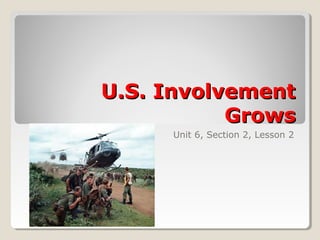
Unit 6 section 2 lesson 2 us involvement grows
- 1. U.S. Involvement Grows Unit 6, Section 2, Lesson 2
- 2. Objectives • Identify the factors that caused President Johnson to increase American troop strength in Vietnam. • Assess the nature of the war in Vietnam and the difficulties faced by both sides. • Evaluate the effects of low morale on American troops and on the home front.
- 3. Terms and People • William Westmoreland − the American military commander in South Vietnam • napalm − jellied gasoline that was dropped in canisters and exploded on impact, setting fire to large areas • hawk − a supporter of Johnson’s war policies • dove − an opponent Johnson’s war policies
- 4. What were the causes and effects of America’s growing involvement in the Vietnam War? As the war escalated, America’s leaders and soldiers found themselves in a quagmire. Eventually the war weakened the American economy, divided the people, and eroded the nation’s morale.
- 5. Vietnam war was different: ◦ No Front Lines “You carried 50 to 70 Enemy was everywhere pounds of equipment, ◦ Terrain was difficult and littered and it was tough going, with mines and traps. ◦ Men, drenched in sweat, would particularly in forested wade through flooded rice areas. Often you’d have paddies and tangled paths. to pull yourself along ◦ Occasionally had to stop to pick leeches out of their boots. from one tree branch to the next, or we’d have to help each other by gripping hands. And you What thoughts and feelings couldn’t see anything, so might a soldier have had in the conditions described by you didn’t know what Sergeant Ehrhart? was there around you.” Sergeant William Ehrhart, United States Marines
- 6. In 1965, Johnson escalated air strikes against North Vietnam and increased the number of ground troops.
- 7. The U.S. plan, called Operation Rolling Thunder, was to Americanize the war effort. The U.S. would use its superior war technology to win the conflict quickly. Johnson’s advisers, including William Westmoreland, the American commander in Vietnam, supported the increased military presence.
- 8. The North Vietnamese and Vietcong fighters proved a difficult enemy. Ho Chi Minh’s military strategy was to fight only when victory was certain. He exhorted his troops to be like a tiger fighting an elephant — the tiger keeps moving and takes bites out of the elephant.
- 9. The Vietcong and North Vietnamese dug a complex series of tunnels, from which they mounted surprise attacks. The U.S. dropped napalm to burn these jungle hideouts.
- 10. The Vietcong and North Vietnamese soldiers: • traveled quickly and quietly with little gear • attacked suddenly and then faded into the jungle • set booby traps around U.S. encampments
- 11. The war grew increasingly difficult and frustrating. • Many American soldiers had been drafted and did not see how the war helped U.S. interests. • The lack of progress toward victory in Vietnam increased doubt about the war. • The war strained America’s economy.
- 12. By 1968, there were more than half a million U.S. troops in Vietnam, and 30,000 had died.
- 13. Doves Hawks supported questioned Johnson’s war the war. They policies. They included liberal were mostly politicians and conservatives students who who believed the saw the conflict war was crucial to as a localized a U.S. Cold War civil war. victory.